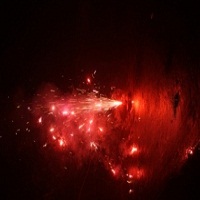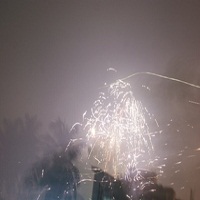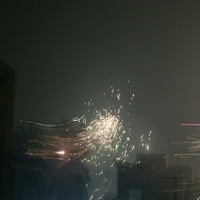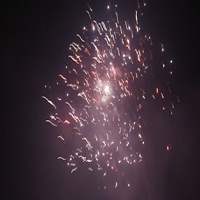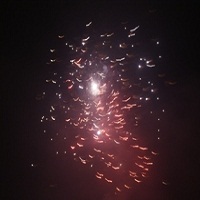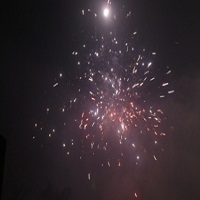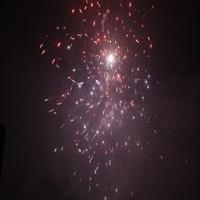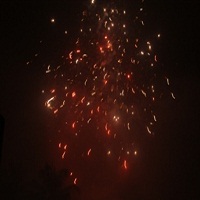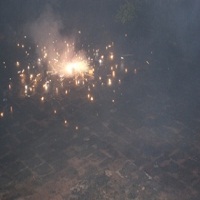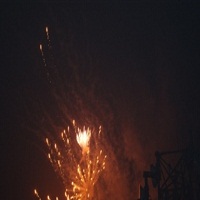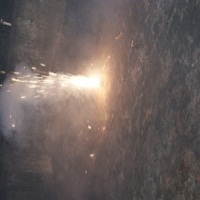Deepavali Festival
Diwali (or Deepavali, the "festival of lights") is an ancient Hindu festival celebrated in autumn (northern hemisphere) every year. Deepavali is the biggest and the brightest festival in India. The festival spiritually signifies the victory of light over darkness. The festival preparations and rituals typically extend over a five-day period, but the main festival night of Deepavali coincides with the darkest, new moon night of the Hindu Lunisolar month Kartika. In the Gregorian calendar, Deepavali falls between mid-October and mid-November
Before Deepavali night, people clean, renovate and decorate their homes and offices. On Deepavali night, Hindus dress up in new clothes or their best outfit, light up diyas (lamps and candles) inside and outside their home, participate in family puja (prayers) typically to Lakshmi - the goddess of wealth and prosperity. After puja, fireworks follow, then a family feast including mithai(sweets), and an exchange of gifts between family members and close friends. Deepavali also marks a major shopping period in nations where it is celebrated.
Deepavali is an important festival for Hindus. The name of festive days as well as the rituals of Diwali vary significantly among Hindus, based on the region of India. In many parts of India, the festivities start with Dhanteras(in Northern & Western part of India), followed by Naraka Chaturdasi on second day, Deepavali on the third day, Diwali Padva dedicated to wife-husband relationship on the fourth day, and festivities end with Bhau-beej dedicated to sister-brother bond on the fifth day. Dhanteras usually falls eighteen days after Dussehra
On the same night that Hindus celebrate Deepavali , Jains celebrate a festival of lights to mark the attainment of moksha by Mahavira, and Sikhs celebrate Bandi Chhor Divas. Diwali is an official holiday in Nepal, India, Sri Lanka, Myanmar,Mauritius, Guyana, Trinidad and Tobago, Suriname, Malaysia, Singapore, Fiji, Pakistan and the Australian external territory of Christmas Island
There is significant variation in regional practices and rituals. Depending on the region, prayers are offered before one or more deities, with most common being Lakshmi - the goddess of wealth and prosperity. On Diwali night, fireworks light up the neighborhood skies. Later, family members and invited friends celebrate the night over food and sweets.
Andhra Pradesh
In Andhra Pradesh, the festivities center over two days - Naraka Chaturthasi and Deepavali Amaavasya. The festivities start out at the crack of dawn and carry on well into the night. Most people make a trip to the local temple along with their families to seek the blessings of their respective gods. The night sky is lit up with a scintillating array of noisy fireworks.
People clean/white-wash or paint/decorate their homes as it is a very auspicious day; to welcome the goddess of wealth and prosperity i.e. Lakshmi devi to their homes. Homes are lit up with hundreds of diyas and colourful diwali rangolis adorn the doorways. After all this preparation all the members of the family perform the Lakshmi puja. Another custom involves decorating homes with paper figures.
Festivities cut across boundaries to move on from the small villages to the big towns, often beginning almost a month before Diwali. Sales of expensive silk saris, jewellery, ornaments, and household goods increase. From the poor to the rich, everyone indulges in the largest shopping spree of the year. Sweets, which are an integral part of any festival in Andhra Pradesh, are prepared or purchased from shops. The festival is full of messages depicting one or more aspects of human life, relationships, and ancient traditions.
Goa and Konkan
Diwali begins in Konkan and Goa on the day of Naraka Chaturdashi. The houses are cleaned and decorated with kandeel(known as Akashdivo in Konkani), lamps, mango leaves, and marigold flowers. The utensils are made to shine, filled with water, and decorated for the holy bath the following morning. On the eve of Naraka Charurdashi, paper-made effigies of Narakasura, filled with grass and firecrackers symbolizing evil, are made. These effigies are burnt at around four o'clock in the morning. Firecrackers are burst, and people return home to take a scented oil bath. Lamps are lit in a line. The women of the house perform aarti of the men, gifts are exchanged, a bitter berry called kareet is crushed under the feet in token of killing Narkasur, symbolising evil and removal of ignorance. Different varieties of Poha and sweets are made and eaten with family and friends. Festivities continue till Tulsi Vivah and lamps are lit every evening. Celebrations include Lakshmi puja on the Diwali day, Krishna puja or Govardhan puja and cattle worship on Balipratipada day, Bhaubeej, and Tulsi vivah.
Gujarat
In Gujarat the Diwali celebrations take on a number of distinct characteristics.
Diwali occurs in the second (dark) lunar fortnight (Krishna Paksha) of the month of Ashvin (Gujarati: "Aaso") and the first (bright) fortnight (Shukla Paksha) of Kartika (Guj: "Kartik"). Also is the last month of the Gujarati calendar, and Kartik the first.
Celebrations start earlier in Gujarat than in the rest of India, commencing on Agyaras, the 11th day of the Krishna Paksha of Aaso. On the 12th day is Vagh Baras, the festival of the cow and the calf. On the 13th day is Dhanteras, the days Diwali starts in the rest of India. The 14th (elsewhere known as Naraka Chaturdashi in South India and Choti Diwali in the North) is celebrated as Kali Choudas. The 15th (new moon day) is Lakshmi Puja, celebrated throughout India. The next day, the first day of Shukla Paksha of Kartik, is Bestu Varsh, New Year's Day, start of the Gujarati calendar. The 2nd day of Kartik is Bhai Bij, the day Diwali ends. A further celebration takes place on the 5th day of Kartik, Labh Pancham.
Karnataka
Known as Deepavali in Karnataka, it is celebrated on the day before and day following Amavasye (New Moon Day) as Naraka Chaturdashi (before new-moon day) resembling Satyabhama's victory over Narakasura and as Bali Padyami, the first day of Kartikamasa. The entire house is cleaned and new clothes are purchased for the entire family which is followed by lighting of oil lamps around the house and bursting firecrackers. The tradition in Kannada families is that all members gather together for the three days celebration.
Kerala
Diwali or popularly known locally as Deepavali, falls on the preceding day of the New Moon in the Malayalam month Thulam (October-November). The celebrations are based on the legend of Narakasura Vadha - where Sri Krishna destroyed the demon and the day Narakasura died is celebrated as Deepavali. It commemorates the triumph of good over evil. The story of King Bali is also associated with Diwali by Hindus in Kerala
Odisha
Diwali is celebrated with great joy. Rows of oil lamps, candles adorn the thresholds of all houses. Firecrackers are burst, sweetmeals are relished and distributed. Some people also worship family goddess. Tarpanam is done in the morning of diwali. All the members of the household gather together just after dusk. After the puja and offerings, the family celebrates Diwali festival by bursting firecrackers. As in other regions, most people prefer to celebrate it in their own homes, though family gatherings are also common. For Diwali houses are brightly lit, with the doors and windows kept open as Lakshmi is supposed to visit every home, and you can't afford to leave it dark and abandoned. Various kinds of Pithas are prepared and given to the deities and forefathers, and enjoyed with family and friends. On Diwali night, many parts of Orissa celebrate Kali Puja, particularly inPuri, Bhadrak, Rourkela, Cuttack & Jajpur area.
Tamil Nadu
Known as Deepavali in Tamil Nadu (meaning lamp lights), it commemorates the death of Narakasura at the hands of Lord Sri Krishna. It is believed that Narakasura, a malevolent demon, tortured common people and they prayed to lord Krishna to defeat him. The people then celebrated Narakasura's defeat with sparklers, lights and firecrackers. This celebration has continued down the generations as Deepavali. In Tamil Nadu, Diwali falls on the 14th day preceding the amavasya (new moon) in the solar month of Aippasi. The day begins with an early morning oil bath, wearing new clothes, bursting of firecrackers, visiting Lord Ganesha, Lord Vishnu and Shiva temples. The exchange of sweets between neighbours, visiting relations, and preparing Deepavali special sweets are traditions of the day.
Typical Deepavali celebrations begin with waking up early in the morning, before sun rise, followed by an oil-bath. The bathing tradition involves extensive massaging of warm til-oil containing pepper corns and betel leaves.[ New clothes are typically worn as a part of celebrations. After the bath, a home-made medicine known as "Deepavali Lehiyam" is consumed, which is supposed to aid in soothing digestive problems that may ensue due to feasting that occurs later in the day. Sparklers, firecrackers and lights are used extensively, much like the rest of the world where Deepavali is celebrated. Though the rest of the country celebrates Diwali traditionally on an amavasya day, Tamil Nadu will celebrate it on the preceding day, Naraka Chaturdashi. In Tamil Nadu, Diwali is calculated when chaturdashi prevails during sunrise, precisely at 4am-6am. If chaturdashi prevails after 6am it is not considered. For example, if chaturdashi tithi begins at 2:30 pm the preceding day and ends at 1pm next day, the next day will be celebrated as Diwali. Contrary to the rest of the nation, diyas are not lit on the night of diwali. Lamps are lit on the night ofKarthikai Deepam, in the Tamil solar month of Karthikai
Telangana
In Telangana the festivities center over two days - Naraka Chaturthasi and Deepavali Amaavasya. People clean/white-wash and paint their homes as it is a very auspicious day; to welcome the goddess of wealth and prosperity i.e. Lakshmi devi to their homes. Homes are lit up with hundreds of diyas and colorful Diwali rangolis adorn the doorways. After all this preparation all the members of the family perform the Lakshmi puja. Sri Kedareswara Vratham is held on Amavasya called Nomu. This is very sacredly performed. There is special thread called the Nomu Dhara, which is tied to the worshiper right hand after performing puja. This custom is acquire through ancestry only. Those families who have this ritual are eligible to perform this puja.
The Goddess Lakshmi is worshiped and food, fruits, nuts, in multiples of 21 are placed in twin winnow as offering to God, new clothes, area nuts, food arranged in plaintain leaf is offered as Naivedya. Adrasam or Kajjaya is a savoury made of rice flour and jaggery then deep fried is specially prepared on this day.
There are some traditional customs followed such as buying new clothes for this festival. Buying new home or vehicles is considered auspicious. Special sweets are made too. Some eateries in Hyderabad make some delicious sweets during Diwali which will not be available at any other time. Some areas may put a huge Narakasura dummy made with fireworks.
